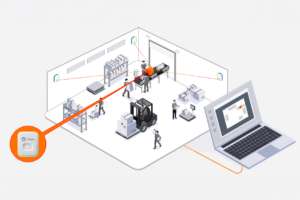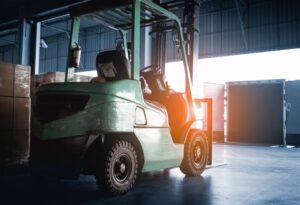Contents
Forklift tracking technology has emerged as a game-changer in the transportation of goods and services within warehouses, offering multiple benefits that enhance operational efficiency. Forklift tracking and fleet management solutions give valuable insights that lead to informed decisions, cost savings, regulatory compliance, and enhanced workplace safety for businesses.
In this blog post, we aim to provide a comprehensive understanding of forklift tracking and its potential to transform your operations. We will explore various advantages of forklift tracking systems, highlighting the long-term cost-saving opportunities they present. By the end of this article, you will have a clearer perspective on whether deploying forklift tracking technology is the right choice for your organization.
What is Forklift Tracking?
Forklift tracking is the implementation of technology to track and monitor forklifts in a warehouse environment. Forklift tracking systems enable users to accurately record, store, and report information related to forklift use, such as location, engine run time, speed, route taken, and more. It also allows users to issue remote commands from a central location, such as sending a forklift to another warehouse area.
The technology consists of several components designed to be used together. On the hardware side, an RFID tag is placed on each forklift, and receivers are installed at various points around the facility. On the software side, there is tracking software where the data is collated and displayed in an easy-to-use dashboard, providing real-time data to the operator and the user.
Benefits of Forklift Tracking and Fleet Management
Now that we understand what forklift tracking is, let’s explore the key benefits it can provide to your organization.
Increased Efficiency
Forklift tracking can boost the efficiency of your warehouse operations by providing real-time data on the movement and utilization of forklifts. This data allows for better planning and scheduling of tasks, identification of problem areas in the workflow, and reduction of wasted time and resources.
Forklift tracking and fleet management systems provide important metrics such as average speed, pallet or machine usage duration, and pallets moved per hour. With this data, managers can allocate staff time effectively and make informed decisions to optimize operations. The system also simplifies the process of locating specific items or equipment in the warehouse, saving time, and streamlining operations.
Improved Safety
Safety is paramount in any warehouse environment, and forklift tracking can contribute to improving safety for operators, customers, pedestrians, and trucks. The system can detect unsafe driving or operator behaviors, such as speeding, harsh braking, and sharp turns, and alert operators to reduce collision risk.
Real-time data on machine location allows managers to ensure correct routes are taken and prevent forklifts from operating in unsafe or unauthorized areas. This helps minimize accidents and reduces the risk of collisions between personnel and machines. Forklift tracking can also help detect potential maintenance issues early on, mitigating breakdowns and accidents.
Additionally, forklift tracking supports a digital logbook, making it easy for operators to record shift activities and providing valuable insights into task completion and areas for improvement.
Decreased Maintenance Costs
Fleet management offers a complete overview of machine performance, alerting managers to service checks and maintenance activities. This reduces downtime and significantly decreases maintenance costs by eliminating the need for manual inspections.
By monitoring the duration and frequency of forklift usage, operators can make informed decisions regarding maintenance schedules. Forklift tracking also aids in the identification of inefficiencies or issues with the machine’s speed control system or brakes.
The data collected through forklift tracking enables the identification of problem areas, leading to cost savings in fuel consumption. Additionally, tracking systems offer valuable insights to managers regarding forklift performance, empowering them to make necessary adjustments and improvements to enhance overall efficiency. Furthermore, with the implementation of BLE technology, unauthorized use of the machines can be detected, ensuring appropriate action can be taken.
Improved Accountability
Forklift tracking improves accountability by providing an audit trail of each forklift and its operator. Managers can easily view a forklift’s location at any point in time, ensuring proper usage and detecting any unauthorized activity. Moreover, it enables efficient tracking of progress, identification of potential issues, and effective management of production schedules and deadlines.
Site managers can utilize the system to determine which tasks have been completed, when they were completed, and by which operators. This capability facilitates accurate tracking of production schedules, ensuring employees adhere to allotted time slots and meet deadlines. Additionally, the recorded data can serve as valuable evidence in the event of disputes between staff members or management.
Implementing these systems empowers companies to maximize the efficiency and responsible use of their fleet. This cutting-edge technology provides enhanced visibility into scheduled tasks, fostering a culture of accountability within the warehouse environment.
Enhanced Compliance
These systems are essential tools for ensuring safe and compliant operations. By providing real-time data on the location, activity, and speed of forklifts, the software helps ensure operators adhere to safety protocols and drive responsibly.
This considerably reduces the risk of accidents and supports businesses in complying with industry regulations. The data collected by the forklift monitoring system serves as evidence of compliance with OSHA and other relevant laws, demonstrating that a company follows best practices for forklift safety.
Furthermore, employers can access detailed reports on employee performance, which can be used to enhance safety training initiatives or implement corrective measures as needed. Implementing a forklift tracking system ultimately enables organizations to achieve a higher level of safety, while also showcasing to regulatory bodies their commitment to employee protection.
Moreover, the data collected by forklift tracking software can be utilized to make informed decisions regarding operational efficiency and cost savings. By gaining complete visibility into the speed and completion time of tasks, as well as the routes taken during goods transportation, employers can identify areas for improvement and implement measures to optimize the warehouse’s efficiency.
Improved Communication
Forklift tracking systems play a crucial role in enhancing communication among employees, employers, and stakeholders. Managers can conveniently access real-time data on the precise location and status of forklifts, enabling them to assign tasks more efficiently. This streamlines operation, saving valuable time and resources by eliminating the need for manual vehicle tracking or on-site assessments.
Additionally, forklift tracking technology facilitates seamless communication between drivers and managers. Drivers can automatically notify managers upon reaching their designated destinations, reducing communication time, and providing real-time updates.
This eliminates the hassle of manual check-ins, which are often time-consuming and prone to errors. Drivers can also access detailed information about the forklift’s condition and performance through real-time location systems, enabling them to take corrective measures if necessary.
Forklift Tracking and Fleet Management with Litum
Litum‘s forklift tracking solution offers a powerful way to optimize operations and maximize productivity. By integrating ultra-wideband (UWB) active RFID technology into battery-powered active RFID tags, businesses gain real-time visibility into their forklifts, reducing the risk of loss or theft while improving efficiency.
Interested to learn more? Contact Litum today.



